The operators' view
Page 81
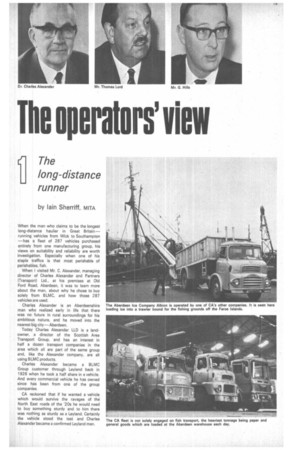
Page 82
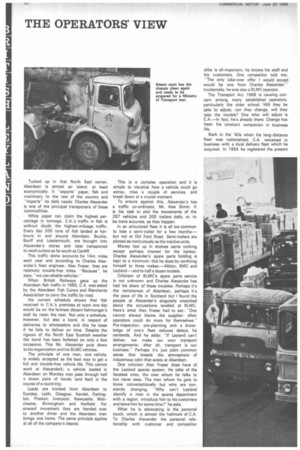
Page 83

Page 87
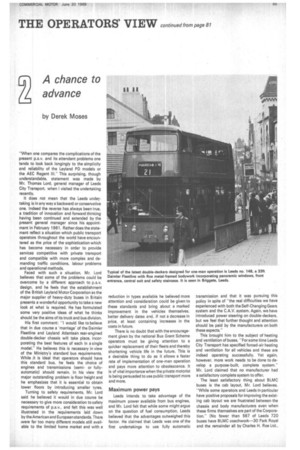
Page 88
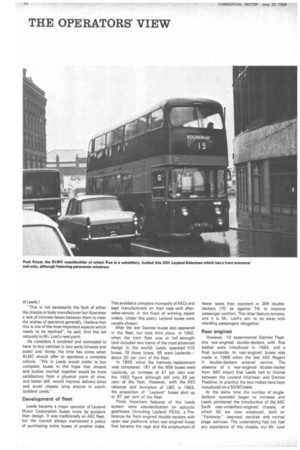
Page 89
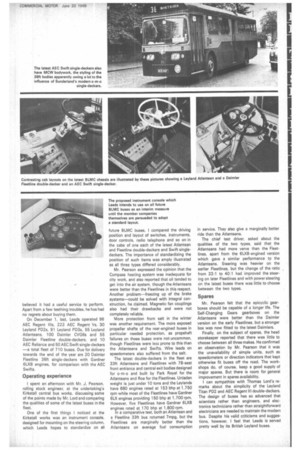
Page 90
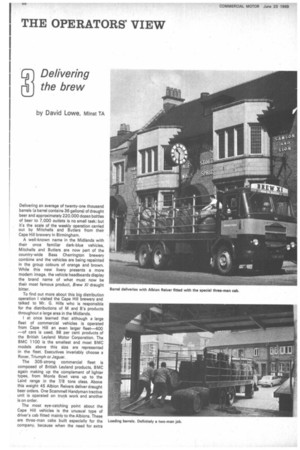
Page 91
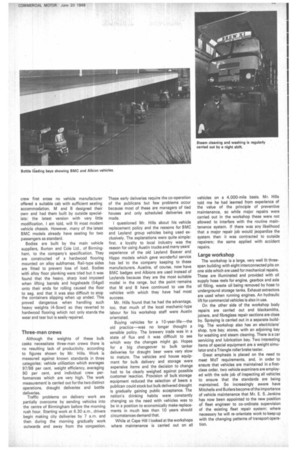
If you've noticed an error in this article please click here to report it so we can fix it.
[1The Llong-distance
runner
by lain Sherriff, MITA
When the man who claims to be the longest long-distance haulier in Great Britain— running vehicles from Wick to Southampton --has a fleet of 287 vehicles purchased entirely from one manufacturing group, his views on suitability and reliability are worth investigation. Especially when one of his staple traffics is that most perishable of perishables, fish.
When I visited Mr. C. Alexander, managing director of Charles Alexander and Partners (Transport) Ltd., at his premises at Old Ford Road, Aberdeen, it was to learn more about the man, about why he chose to buy solely from BLMC, and how those 287 vehicles are used.
Charles Alexander is an Aberdeenshire man who realized early in life that there was no future in rural surroundings for his ambitious nature, and he moved into the nearest big city—Aberdeen.
Today Charles Alexander LLD is a landowner. a director of the Scottish Area Transport Group, and has an interest in half a dozen transport companies in the area which all are part of the same group and, like the Alexander company, are all using BLMC products.
Charles Alexander became a BLMC Group customer through Leyland back in 1926 when he took a half share in a vehicle. And every commercial vehicle he has owned since has been from one of the group companies.
CA reckoned that if he wanted a vehicle which would survive the ravages of the North East roads of the '20s he would need to buy something sturdy and to him there was nothing as sturdy as a Leyland. Certainly the vehicle stood the test and Charles Alexander became a confirmed Leyland man. Tucked up in that North East corner, Aberdeen is almost an island, at least economically, It "exports" paper, fish and machinery to the rest of the country and "imports" its daily needs. Charles Alexander is one of the principal transporters of these commodities.
While paper can claim the highest percentage in tonnage. C.A.'s traffic in fish is without doubt the highest-mileage traffic. Every day 200 tons of fish landed at harbours in and around Aberdeen. Buckie, Banff and Lossiemouth. are brought into Alexander's stores and later transported to retail outlets as far south as Cardiff.
This traffic alone accounts for 14m. miles each year and according to Charles Alexander's fleet engineer. Alex Fraser, they are relatively trouble-free miles. "Because", he says, "we use reliable vehicles."
When British Railways gave up the Aberdeen fish traffic in 1965, C.A. was asked by the Aberdeen Fish Curers and Merchants Association to carry the traffic by road.
His current schedule shows that fish received in C.A.'s premises at noon one day would be on the farthest distant fishmonger's stall by noon the next. Not only a schedule, however, but also a bond, in respect of deliveries to wholesalers and this he loses if he fails to deliver on time. Despite the rigours of the North East Scottish weather the bond has been forfeited on only a few occasions. This Mr. Alexander puts down to his organization and his BLMC vehicles.
The principle of one man, one vehicle. is widely accepted as the best way to get a full and trouble-free vehicle life. This cannot work at Alexander; a vehicle loaded in Aberdeen on Monday may pass through half a dozen pairs of hands (and feet) in the course of a round trip.
Loads are trunked from Aberdeen to Dundee. Leith, Glasgow, Kendal, Darlington. Preston, Liverpool, Newcastle. Manchester, Birmingham and Hatfield. For onward movement they are handed over to another driver and the Aberdeen man brings one home. The same principle applies at all of the company's depots.
This is a complex operation and it is simple to visualize how a vehicle could go astray, miss a couple of services, and break down at a crucial moment.
To ensure against this. Alexander's has a traffic co-ordinator, Mr. Alex Simm. It is his task to plot the movements of the 287 vehicles and 200 trailers daily, or, to be more accurate, as they happen.
In an articulated fleet it is all too common to lose a semi-trailer for a few months— but not at Old Ford Road. Semi-trailers are plotted as meticulously as the tractive units.
Money tied up in shelves earns nothing except perhaps interest for the banker. Charles Alexander's spare parts holding is kept to a minimum: this he does by confining himself to three makes—Albion, BMC and Leyland —and to half a dozen models.
Criticism of BLMC's spare parts service is not unknown and Charles Alexander has had his share of these troubles. Perhaps it's the remoteness of Aberdeen, perhaps it's the pace of life in Scotland but I found the people at Alexander's singularly unexcited about the accusations levelled at BLMC. Here's what Alex Fraser had to say: "One cannot always blame the supplier: often operators could do more for themselves." Pre-inspection. pre-planning and a knowledge of one's fleet reduces delays. he contends. And he adds: "If Leyland can't deliver, we make our own transport arrangements: after all, transport is our business." Perhaps it's just plain ,common sense that breeds the atmosphere of industrious calm that exists at Aberdeen.
One criticism Alex Fraser does have of the Leyland spares system. He talks of the faceless ones, the men whom he talks to but never sees. The men whom he gets to know conversationally but who are constantly changing. -Why can't Leyland identify a man in the spares department with a region, introduce him to his customers and leave him for some time?" he asks.
What he is advocating is the personal touch, which is almost the hallmark of C.A. To Charles Alexander the personal relationship with customer and competitor alike is all-important; he knows his staff and his customers. One competitor told me: "The only take-over offer I would accept would be one from Charles Alexander." Incidentally. he was also a BLMC operator.
The Transport Act 1968 is causing concern among many established operators. particularly the older school. Will they be able to adjust, can they change, will they take the trouble? One who will adjust is CA.—in fact, he's already there. Change has been his constant companion in business life.
Back in the '40s when his long-distance fleet was nationalized, C.A. remained in business with a local delivery fleet which he acquired. In 1954 he registered the present
company, which was without vehicles and was non-trading. He had anticipated the fall of the Labour Government and consequently denationalization_ When it came he acquired two BRS units and was back in business in a big way.
Now, although his vehicles operate from Wick and Thurso to Dover and Southampton they don't run into Europe. "There's enough to do at home", he says; and this is what he plans to do.
With 90 vehicles not exceeding 16 tons gross plated weight, and depots well placed throughout the country, traffic for these vehicles is assured. If special authorizations are ever introduced, and this now seems highly unlikely, his -heavieswill have little
trouble finding work. British Railways can hardly object to long-distance fish traffic going by road after all they gave it up.
Proud possession
Among CA's proudest possessions is the Leyland Lynx. He waxes eloquent over this one: "50,000 trouble-free miles in the first six months-, he claims. He thinks that Leyland analysed the faults of every diesel engine ever made and then built the Lynx with every possible fault eliminated.
There's something simple yet solid about the Alexander organization. For example there is no special chassis treatment against corrosion and fish slime—just an alloy
platform built on the premises and, of course, a service at home base each week. All vehicles go to Aberdeen once a month.
There is no refrigeration for the fish, just platform lorries and a good blast of fresh air across the load as it travels: and of course the load does not get old enough to "go off".
Today's fleet, in fact, is proving as reliable as that first Leyland. They keep running, and all the vehicles submitted for the MoT test have passed first time.
Which may explain why, when I asked Charles Alexander bluntly: -What's wrong with British Leyland?" he answered: "Not very much". fl A chance to
advance
by Derek Moses
"When one compares the complications of the present p.s.v. and its attendant problems one tends to look back longingly to the simplicity and reliability of the Leyland PD models or the AEC Regent III." This surprising, though understandable, statement was made by Mr. Thomas Lord, general manager of Leeds City Transport, when I visited the undertaking recently.
It does not mean that the Leeds undertaking is in any way a backward or conservative one. Indeed the reverse has always been true, a tradition of innovation and forward thinking having been continued and extended by the present general manager since his appoint ment in February 1961. Rather does the statement reflect a situation which public transport operators throughout the world have encountered as the price of the sophistication which has become necessary in order to provide services competitive with private transport and compatible with more complex and demanding traffic conditions, labour problems and operational methods.
Faced with such a situation, Mr. Lord believes that some of the problems could be overcome by a different approach to p.s.v. design, and he feels that the establishment of the British Leyland Motor Corporation as the major supplier of heavy-duty buses in Britain presents a wonderful opportunity to take a new look at what is required. He has formulated some very positive ideas of what he thinks should .be the aims of its truck and bus division.
His first comment: "I would like to believe that in due course a 'marriage' of the Daimler Fleetline and Leyland Atlantean rear-engined double-decker chassis will take place, incorporating the best features of each in a single model.He believes this is necessary in view of the Ministry's standard bus requirements. While it is ideal that operators should have this standard bus, he feels the choice of engines and transmissions Isemior fullyautomatic) should remain. In his view the major outstanding problem is floor height and he emphasizes that it is essential to obtain lower floors by introducing smaller tyres.
Turning to safety requirements, Mr. Lord said he believed it would in due course be necessary to give more consideration to safety requirements of p.s.v., and felt this was well illustrated in the requirements laid down by the American and European standards. There were far too many different models still available to the limited home market and with a reduction in types available he believed more attention and consideration could be given to these standards and bring about a marked improvement in the vehicles themselves, better delivery dates and, if not a decrease in price, at least containing increases in the costs in future.
There is no doubt that with the encouragement given by the national Bus Grant Scheme operators must be giving attention to a quicker replacement of their fleets and thereby shortening vehicle life in the future. This is a desirable thing to do as it allows a faster rate of implementation of one-man operation and pays more attention to obsolescence. It is of vital importance when the private motorist is being persuaded to use public transport more and more.
Maximum power pays
Leeds intends to take advantage of the maximum power available from bus engines, and Mr. Lord felt that while some might argue on the question of fuel consumption, Leeds believed that the advantages outweighed this factor. He claimed that Leeds was one of the first undertakings to use fully automatic transmission and that it was pursuing this policy in spite of "the real difficulties we have experienced with both the Self-Changing Gears system and the C.A.V. system. Again, we have introduced power steering on double-deckers, but we feel that further thought and attention should be paid by the manufacturers on both these aspects."
This brought him to the subject of heating and ventilation of buses. "For some time Leeds City Transport has specified forced-air heating and ventilation for all vehicles and these are indeed operating successfully. Yet again. however, more work needs to be done to develop a purpose-built, complete system." Mr. Lord claimed that no manufacturer had a satisfactory complete system to offer.
The least satisfactory thing about BLMC buses is the cab layout, Mr. Lord believes. "While some operators and Leeds in particular have positive proposals for improving the existing cab layout we are frustrated between the chassis and body manufacturers even when these firms themselves are part of the Corporation." (No fewer than 567 of Leeds 720 buses have BUVIC coachwork-30 Park Royal and the remainder all by Charles H. Roe Ltd., of Leeds.) "This is not necessarily the fault of either the chassis or body manufacturer but illustrates a lack of intimate liaison between them to meet the wishes of operators generally. I believe that this is one of the most important aspects which needs to be resolved", he said. And this led naturally to Mr. Lord's next point.
He considers it outdated and outmoded to have to buy vehicles in two parts (chassis and body) and thinks the time has come when BLMC should offer to operators a complete vehicle. "We in Leeds would prefer to buy complete buses in the hope that chassis and bodies married together would be more satisfactory from a physical point of view, and better still, would improve delivery dates and avoid chassis lying around in coachbuilders yards."
Development of fleet
Leeds became a major operator of Leyland Motor Corporation buses more by accident than design. It was traditionally an AEC fleet, but the council always maintained a policy of purchasing some buses of another make. This avoided a complete monopoly of AECs and kept manufacturers on their toes with aftersales-service in the hope of winning repeat orders. Under this policy Leyland buses were usually chosen.
After the war Daimler buses also appeared in the fleet, but took third place. In 1952, when the tram fleet was at full strength (and included two trams of the most advanced design in the world) Leeds operated 415 buses. Of these buses, 85 were Leylandsabout 20 per cent of the fleet.
In 1959, when the tramway replacement was completed, 181 of the 654 buses were Leylands. an increase of 47 per cent over the 1952 figure although still only 28 per cent of the fleet. However, with the AEC takeover and formation of LMC in 1963. the proportion of "Leyland" buses shot up to 87 per cent of the fleet.
Three important features of the Leeds system were standardization on epicyclic gearboxes (including Leyland PD2s). a Preference for front-engined double-deckers with open rear platforms when rear-engined buses first became the rage and the employment of fewer seats than standard in 30ft doubledeckers (70 as against 74) to improve passenger comfort. This latter feature remains, and it is Mr. Lord's aim to do away with standing passengers altogether.
Rear engines
However. 10 experimental Daimler Fleetline rear-engined double-deckers with Roe bodies were introduced in 1964. and a final surrender to rear-engined buses was made in 1966 when the last AEC Regent V double-deckers entered service. The absence of a rear-engined double-decker from AEC meant that Leeds had to choose between the Leyland Atlantean and Daimler Fleetline. In practice the two makes have been introduced on a 50/50 basis.
At the same time the number of singledeckers operated began to increase and Leeds pioneered the introduction of the AEC Swift rear-underfloor-engined chassis, of which 50 are now employed, both on "Fastaway" (express) services and normal stage services. The undertaking had not had any experience of this chassis, but Mr. Lord believed it had a useful service to perform. Apart from a few teething troubles, he has had no regrets about buying them.
On December 1, last. Leeds operated 96 AEC Regent Ills, 223 AEC Regent Vs. 30 Leyland PD2s, 91 Leyland P03s, 55 Leyland Atlanteans, 100 Daimler CVG6s and 55 Daimler Fleetline double-deckers. and 10 AEC Reliance and 50 AEC Swift single-deckers —a total fleet of 710 buses. Due for delivery towards the end of the year are 20 Daimler Fleetline 36ft single-deckers with Gardner 6LXB engines, for comparison with the AEC Swifts.
Operating experience
I spent an afternoon with Mr. J. Pearson, rolling stock engineer, at the undertaking's Kirkstall central bus works, discussing some of the points made by Mr. Lord and comparing the qualities of some of the latest buses in the fleet.
One of the first things I noticed at the Kirkstall works was an instrument console, designed for mounting on the steering column, which Leeds hopes to standardize on all future BLMC buses. I compared the driving position and layout of switches, instruments, door controls, radio telephone and so on in the cabs of one each of the latest Atlantean and Fleetline double-deckers and Swift singledeckers. The importance of standardizing the position of such items was amply illustrated as all three types differed considerably.
Mr. Pearson expressed the opinion that the Compass heating system was inadequate for city work, and also reported that oil tended to get into the air system, though the Atlanteans were better than the Fleetlines in this respect. Another problem--freezing up of the brake systems—could be solved with integral con struction, he claimed. Magnetic fan couplings also had their drawbacks and were not completely reliable.
More protection from salt in the winter was another requirement. The more exposed propeller shafts of the rear-engined buses in particular needed protection, as propshaft failures on these buses were not uncommon, though Fleetlines were less prone to this than the Atlanteans and Swifts. Wire leads on speedometers also suffered from the salt.
The latest double-deckers in the fleet are 33ft Atlanteans and Fleetlines with 78-seat front entrance and central exit bodies designed for o-m-o and built by Park Royal for the Atlanteans and Roe for the Fleetlines. Unladen weight is just under 10 tons and the Leylands have 680 engines rated at 153 bhp at 1,750 rpm while most of the Fleetlines have Gardner 6LX engines providing 150 bhp at 1,700 rpm. However. five Fleetlines have Gardner 6LXB engines rated at 170 bhp at 1,800 rpm.
In a comparative test, both an Atlantean and a Fleetline 33ft bus returned 7mpg, but the Fleetlines are marginally better than the Atlanteans on average fuel consumption in service. They also give a marginally better ride than the Atlanteans.
The chief test driver, asked about the qualities of the two types, said that the Atlanteans had more verve than the Fleetfines, apart from the 6LXB-engined version which gave a similar performance to the Atlanteans. Steering was heavier on the earlier Fleetlines, but the change of the ratio from 33:1 to 40:1 had improved the steering on later Fleetlines and with power steering on the latest buses there was little to choose between the two types.
Spares
Mr. Pearson felt that the epicyclic gearboxes should be capable of a longer life. The Self-Changing Gears gearboxes on the Atlanteans were better than the Daimler version on the early Fleetlines. but a stronger box was now fitted to the latest Daimlers.
Finally, on the subject of spares, the head storekeeper reported that there was little to choose between all three makes. He confirmed an observation by Mr. Pearson that it was the unavailability of simple units, such as speedometers or direction indicators that kept otherwise fit buses off the road. The workshops do, of course, keep a good supply of major spares. But there is room for general improvement in spares availability.
I can sympathize with Thomas Lord's remarks about the simplicity of the Leyland Titan PD2 and AEC Regent III double-deckers. The design of buses has so advanced that scientists rather than engineers, and elec tronics technicians rather than straightforward electricians are needed to maintain the modern bus. Despite his valid criticisms and suggestions. however. I feel that Leeds is served pretty well by its British Leyland buses.
Delivering the brew
by David Lowe, wrist TA
Delivering an average of twenty-one thousand barrels (a barrel contains 36 gallons) of draught beer and approximately 220.000 dozen bottles of beer to 7,000 outlets is no small task: but its the scale of the weekly operation carried out by MitchelIs and Butlers from their Cape Hill brewery in Birmingham.
A well-known name in the Midlands with their once familiar dark-blue vehicles, MitchelIs and Butlers are now part of the country-wide Bass Charrington brewery combine and the vehicles are being repainted in the group colours of orange and brown. While this new livery presents a more modern image, the vehicle headboards display the brand name of what must now be their most famous product, Brew XI draught bitter.
To find out more about this big distribution operation I visited the Cape Hill brewery and talked to Mr. G. Hills who is responsible for the distributions of M and B's products throughout a large area in the Midlands.
I at once learned that although a large fleet of commercial vehicles is operated from Cape Hill an even larger fleet-400 —of cars is used, 98 per cent products of the British Leyland Motor Corporation. The BMC 1100 is the smallest and most BMC models above this size are represented in the fleet. Executives invariably choose a Rover, Triumph or Jaguar.
The 305-strong commercial fleet is composed of British Leyland products, BMC again making up the complement of lighter types, from Morris 6cwt vans up to the Laird range in the 7/8 tons class. Above this weight 45 Albion Reivers deliver draught beer orders. One Scammell Handyman tractive unit is operated on trunk work and another is on order.
The most eye-catching point about the Cape Hill vehicles is the unusual type of driver's cab fitted mainly to the Albions. These are three-man cabs built especially for the company, because when the need for extra crew first arose no vehicle manufacturer offered a suitable cab with sufficient seating accommodation. M and B designed their own and had them built by outside specialists; the latest version with very little modification, I am told, will fit most modern vehicle chassis. However, many of the latest BMC models already have seating for two passengers as standard.
Bodies are built by the main vehicle suppliers, Burton and Cole Ltd., of Birmingham. to the company's specification. They are constructed of a hardwood flooring mounted on alloy subframes. Rail-type sides are fitted to prevent loss of load. Bodies with alloy floor planking were tried but it was found that the heavy, sharp load imposed when lifting barrels and hogsheads (54ga1) onto their ends for rolling caused the floor to sag, and that it was also difficult to stop the containers slipping when up ended. This proved dangerous when handling such heavy weights (4-5cwt) so they reverted to hardwood flooring which not only stands the wear and tear but is easily repaired.
Three-man crews
Although the weights of these bulk casks necessitate three-man crews there is no resulting lack of productivity, according to figures shown by Mr. Hills. Work is measured against known standards in three categories: vehicle utilization which averages 97/98 per cent, weight efficiency, averaging 90 per cent, and individual crew performances which are very high. The work measurement is carried out for the two distinct operations, draught deliveries and bottle deliveries.
Traffic problems on delivery work are partially overcome by sending vehicles into the centre of Birmingham before the morning rush hour. Starting work at 6.30 a.m., drivers begin making city deliveries by 7 a.m, and then during the morning gradually work outwards and away from the congestion. These early deliveries require the co-operation of the publicans but few problems occur because most of these are managers of tied houses and only scheduled deliveries are made.
I questioned Mr. Hills about his vehicle replacement policy and the reasons for BMC and Leyland group vehicles being used exclusively. The explanations were quite simple: first, a loyalty to local industry was the reason for using Austin trucks and many years' experience of the old Leyland Beaver and Hippo models which gave wonderful service has led to the company keeping to these manufacturers. Austins, of course, now have BMC badges and Albions are used instead of Leylands because they are the most suitable model in the range, but the point -remains that M and B have continued to use the vehicles with which they have had most success.
Mr. Hills found that he had the advantage. too, that much of the local mechanic-type labour for his workshop staff were Austin orientated.
Buying vehicles for a 10-year-life—the old practice--was no longer thought a sensible policy. The brewery trade was in a state of flux and it was difficult to see which way the changes might go. Hopes for a big changeover to bulk tanker deliveries for draught beer were very slow to mature. The vehicles and house equipment for bulk delivery and storage were expensive items and the decision to change had to be clearly weighed against possible customer reaction. Provision of bulk storage equipment reduced the selection of beers a publican could stock but bulk delivered draught is gradually gaining public acceptance. The nation's drinking habits were constantly changing so the need with vehicles was to be in a position to economically make replacements in much less than 10 years should circumstances demand that.
While at Cape Hill I looked at the workshops where maintenance is carried out on all vehicles on a 4.000-mile basis. Mr. Hills told me he had learned from experience of the value of the principle of preventive maintenance, so while major repairs were carried out in the workshop these were not allowed to interfere with the routine maintenance system. If there was any likelihood that a major repair job would jeopardize the system then it was contracted to outside repairers; the same applied with accident repairs.
Large workshop
The workshop is a large, very well lit threespan building with eight interconnected pits on one side which are used for mechanical repairs. These are illuminated and provided with oil supply hose reels for engine, gearbox and axle oil filling, waste oil being removed by hose to underground storage tanks. Exhaust extractors are used when running engines. An hydraulic lift for commercial vehicles is also in use.
On the other side of the workshop body repairs are carried out and blacksmiths, joiners, and fibreglass repair sections are close by. Spraying is carried out in a separate building. The workshop also has an electricians' shop, tyre bay, stores, with an adjoining bay for washing and steam cleaning. There is a car servicing and lubrication bay. Two interesting items of special equipment are a weight simulator and a Triangle roller brake tester.
Great emphasis is placed on the need to meet MoT requirements, and, in order to ensure that vehicles are maintained in a firstclass order, two vehicle examiners are employed with the sole job of inspecting all vehic!es to ensure that the standards are being maintained. So increasingly aware have Mitchells and Butlers become of the importance of vehicle maintenance that Mr. E. S. Jenkins has now been appointed to the new position of fleet engineer to co-ordinate supervision of the existing fleet repair system; where necessary he will re-orientate work to keep up with the changing patterns of transport operation.










































































































































































































































































